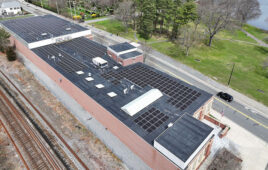The Illinois Commerce Commission (ICC) voted 4-1 on Wednesday to reject Ameren Illinois’ proposed calculation of the number of solar net-metering customers in its territory, resulting in the reopening of full retail net metering in its service territory. The decision will allow new solar customers to participate in the widely used solar compensation mechanism that provides a bill credit equal to the retail rate for excess energy sent to the grid.
“Illinoisans have endured enough chaos this year. This small victory for a stable clean energy market is a big relief for the thousands of workers whose jobs hinge on fair solar policy,” said Will Kenworthy, Vote Solar regulatory director, Midwest. “Looking ahead to 2021, maintaining solar savings will be key to preserving clean energy choice for downstate families and businesses, and keeping the state on track with our climate goals.”
Clean energy groups argued that Ameren distorted Illinois statute in order to avoid its legal responsibility to fairly compensate rooftop solar and help Illinois meet its clean energy goals. In July, an ICC administrative law judge found that Ameren’s calculation of the cap on the number of customers using net metering was wrong, and concluded Ameren should continue crediting customers the full retail value for their solar energy until the 5% threshold set in the law is met, currently estimated to be at least two more years.
“Yesterday’s Order confirms that Ameren’s decision to end retail net metering in October was premature and unlawful,” said Nikhil Vijaykar, Staff Attorney at the Environmental Law and Policy Center. “Fair access to retail net metering is a key ingredient in Illinois’ steady clean energy transition.”
“We are grateful to the Commission for following through on our state’s commitment to creating jobs, protecting consumers and expanding clean energy,” said Nakhia Morrissette, Central Region Director & Counsel for SEIA. “This is a victory for consumers and independent clean energy businesses.”
The Solar Energy Industries Association, Illinois Solar Energy Association, Coalition for Community Solar Access, Environmental Law & Policy Center, Natural Resources Defense Council and Vote Solar alerted the ICC back in April of this year that the incorrect methodology that Ameren was using was artificially accelerating us towards the 5% cap. Those groups then filed an emergency motion with the ICC in September to prevent Ameren from ending net metering for new solar customers in Southern and Central Illinois.
Ameren Illinois issued the following statement in response to the ruling:
“We will take the time we need to thoroughly review the order and consult with legal counsel to determine whether a rehearing or appeal is warranted. It is too soon to know how the new tariff can be implemented.
“Ameren Illinois filed a tariff three years ago and it was based on an express reading of the statute. Up until December 2, the ICC approved and enforced it in accordance with our tariff.
“We continue to agree with the underlying policy embedded in the law with respect to the 5% solar penetration threshold. As net metering expands in our state, the subsidy being paid by non-net metering customers grows as well. Some customers cannot afford solar facilities to be installed on their homes, and the law recognizes that it’s unfair to increase their rates to pay for services provided to other customers. All customers benefit from our energy delivery grid that makes power available 24/7, and all customers benefit from the labor performed by our employees to maintain that grid, provide reliable service and get the lights back on quickly after storms.
“The regulatory process is just that — a process. It continues to evolve and change and there are times when we agree with an outcome and times we don’t — but the underlying policies are important and the debate that surrounds those policies is healthy and will continue. We are all after the same result — fair and constructive energy policy for Illinois.”
News item from Vote Solar. Updated with Ameren’s statement at 4:30 p.m. ET.





It’s a 5% cap and ‘they’ think this is still two years away. The next run the utility takes at net metering will depend on what the industry as a whole “thinks” FERC ruling 2222 does for ‘all’ alternative energy generation resources, that includes utility scale solar PV farms and residential solar PV arrays on roofs. IF this is determined to be “part of the Federal” wholesale energy market, all solar PV installations will become net billing and the price point of the excess energy pushed back onto the grid will be credited at the ‘wholesale’ energy price. This has the smell of many years of court battles before a firm determination is made.
“As net metering expands in our state, the subsidy being paid by non-net metering customers grows as well. Some customers cannot afford solar facilities to be installed on their homes, and the law recognizes that it’s unfair to increase their rates to pay for services provided to other customers. All customers benefit from our energy delivery grid that makes power available 24/7, and all customers benefit from the labor performed by our employees to maintain that grid, provide reliable service and get the lights back on quickly after storms.”
The so called subsidy is the business model of the utility and has less to do with “non-net metering” customers getting a rate increase. The utility had been given the opportunity to file a rate case for “lost revenues” when ratepayers adopt energy efficiency programs or install solar PV on their homes to generate power for their daily needs, the utility doesn’t sell as much electricity as it did. Utilities also have been in the practice of filing rate cases for electricity rate increases based on old fueled generation or transmission assets that need to be replaced but are not “paid for” in use. These “stranded asset” cases are coming more often now that the fueled generation plants are ageing and near the end of life. So, basically with or without solar PV on the adopters roofs, the utility will raise rates to insure their revenue streams.
As for the labor performed and the “grid” infrastructure, utilities are able to depreciate old assets on their taxes, does this money go “back” into the system to help with the O&M costs? Yeah, I don’t think so. When my solar PV system generates excess energy that goes right next door to the neighbor’s house, does the utility take off the TD&D and “fuel charges” bundled into every kWh of solar PV generated electricity used in the neighbor’s home, of course not. The utilities “need” to learn how to partner with distributed energy generation resources in a bi-directional grid that can be used for the trade and shuttling of energy for grid services used in aggregate VPP entities.